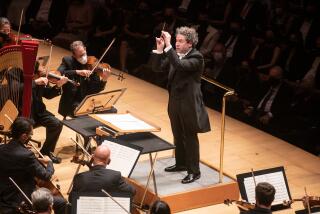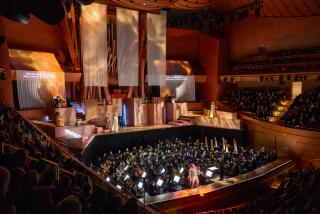A golden, global evening with chorale
Sunday night, Walt Disney Concert Hall was full yet it was empty. The Los Angeles Master Chorale performed. But there was no feeling, no perception, no sound. No pure intonation and no impure intonation. No increase in volume and no decrease in volume. It was a marvelous concert. You may have guessed that Buddhism was involved.
The program began with the late Lou Harrison’s “La Koro Sutro,” which consists of the “Heart” Sutra -- an important Buddhist scripture expressing the paradox that form is emptiness and emptiness form -- sung in Esperanto. After intermission, the chorale premiered Cambodian composer Chinary Ung’s “Spiral XII: Space Between Heaven and Earth.” His Cambodian, Pali, Sanskrit and English text was not translated, but the program notes explained that Ung introduces “compassionate textures,” presumably the work’s alluring sliding tones, into the void. Ung also introduced into his work eight exquisite Cambodian dancers who filled the void.
With a remarkably wide global context, the concert commemorated the 70th anniversary of Kristallnacht, the single night when, throughout Germany, nearly 100 Jews were murdered and thousands were arrested and deported to concentration camps. The Buddhist texts applied through preaching peace. The international language Esperanto was banned by the Nazis. In “Spiral XII,” Ung, who moved to the U.S. in 1964 and teaches at UC San Diego, reflects on the Cambodian holocaust, the murder by the Khmer Rouge of more than a million people.
“La Koro Sutro” -- for chorus, a homemade gamelan that Harrison dubbed “Old Granddad,” harp and organ -- was written in 1972 for a conference of Esperanto scholars. The “Heart” is the shortest of the Buddhist scriptures called sutras. Some can run 100,000 lines. But the “Heart” is comfortably set in a 25-minute score. You do need, however, a lifetime or two to completely understand how the mind awakens by going, going, going beyond going, completely beyond going. . . .
Harrison wrote here in a captivating style half Javanese, half California craftsman. Lovingly constructed, endlessly flowing melodies are stirred into a creamy vocal texture. Old Granddad, which is housed at Stanford and lent out for performances, has seen better days, but the gamelan, which includes a couple of particularly mellow-sounding trash-can drums, nevertheless twinkled and glistened with excited bell-and-chimes glitter. The Disney organ was a plush plus. Master Chorale Music Director Grant Gershon balanced his opulent chorus and the spirited if a tad sour Old Granddad with aplomb.
“Spiral XII” is the third in a series of commissions by the Master Chorale intended to bring composers and soloists from various world music traditions into the realm of Western choral music. Sophiline Cheam Shapiro, a Cambodian dancer and choreographer who is based at UCLA, made the dance for herself and the Khmer Arts Ensemble (seven young women who had traveled from Cambodia). In describing the story of her dance as the overpowering of good by evil, Shapiro said she would say more about how good was ultimately reconciled when she had more time.
The fascinating music was made of choral lines intertwining, with swirling accompaniments by strings, winds and percussion stirred in. Sopranos Elissa Johnston and Kathleen Roland were glossy icing on this rich cake. A Cambodian drummer sat off to the side, still most of the time.
Ung exploits techniques -- sung harmonics, whistling, curious percussion noises -- that have floated around East and West for some time. But nothing sounded the way a glance at the score had suggested it would. The unspeakably beautiful choral writing, blended in such a way that the ear could never quite tell who was doing what, felt magically made.
The piece is long and less feet-on-the-ground in its “Song Offerings” opening than in the dramatic, danced “Prelude and Space Between Heaven and Earth.” Still, this was gorgeous music superbly performed. Under Gershon, the Master Chorale seems to be able to master anything. Now let it master a source of funds and make a recording of Ung’s extraordinary score. It could catch on big time.
And while the ensemble is at it, why not shop this intriguing program around to festivals? I can’t think of any suitable ones, in the East or West, that such music wouldn’t enhance.
More to Read
The biggest entertainment stories
Get our big stories about Hollywood, film, television, music, arts, culture and more right in your inbox as soon as they publish.
You may occasionally receive promotional content from the Los Angeles Times.







